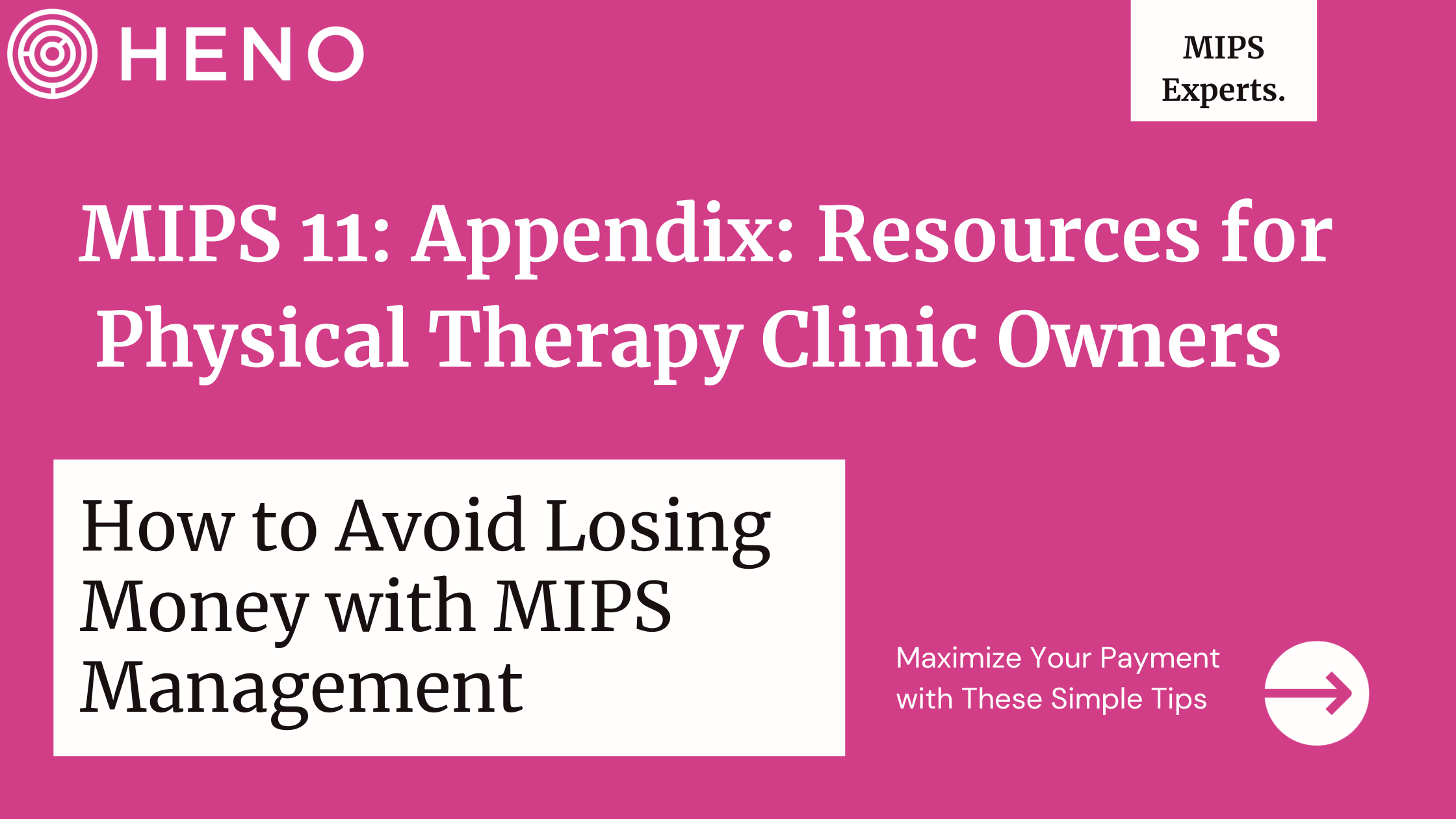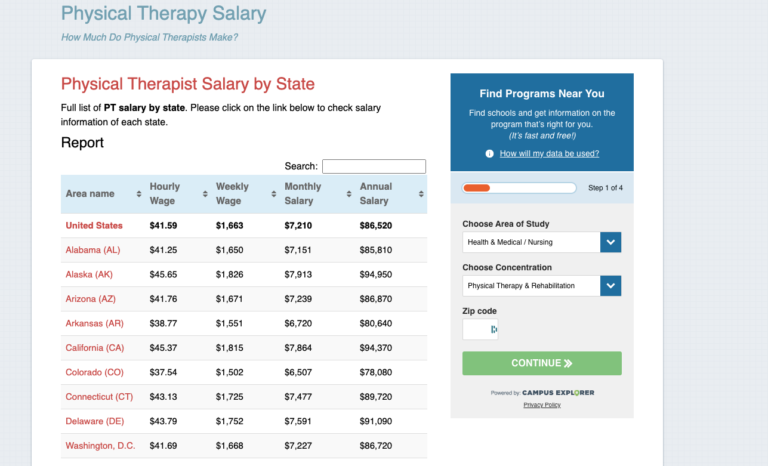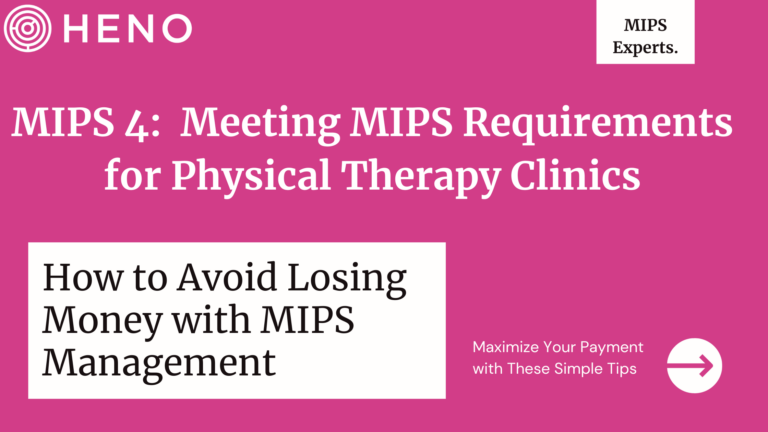MIPS 11: Appendix: Resources for Physical Therapy Clinic Owners

In this article we’ll explore MIPS Compliance and Audits. If you haven’t already read the first 3 articles in this series, you can click the following to read them, and if you need the MIPS Quick start guide from Medicare you can get that here.
- Article 1
- Article 2
- Article 3
- Article 4
- Article 5
- Article 6
- Article 7
- Article 8
- Article 9
- Article 10
MIPS Reporting Tools and Software
In today’s ever-evolving healthcare landscape, it has become imperative for Physical Therapy Clinic Owners to stay updated with the latest regulations and requirements. One such regulation that has gained significant importance is the Merit-based Incentive Payment System (MIPS). As a Physical Therapy Clinic Owner, understanding and effectively implementing MIPS can not only improve patient care but also boost your clinic’s financial health.
To ensure seamless MIPS reporting and compliance, Physical Therapy Clinic Owners must leverage the power of advanced reporting tools and software. These tools offer an array of features designed specifically to streamline reporting processes and maximize financial incentives.
One of the key benefits of using MIPS reporting tools and software is the automation of data collection and submission. These tools eliminate the need for manual data entry by integrating with electronic health record (EHR) systems, making the process more efficient and accurate. By automating data collection, Physical Therapy Clinic Owners can save time and resources, allowing them to focus on providing quality care to their patients.
MIPS reporting tools also provide real-time data analytics and feedback, enabling clinic owners to monitor their performance throughout the reporting period. These insights help identify areas of improvement, enabling clinics to make necessary adjustments and optimize their MIPS score. By utilizing this information, Physical Therapy Clinic Owners can enhance their performance and increase their chances of receiving higher reimbursement rates.
Furthermore, MIPS reporting tools and software offer comprehensive dashboards that display performance metrics, quality measures, and other relevant data in an easy-to-understand format. This visual representation enables clinic owners to track their progress and identify the specific measures that require attention. By having a clear overview of their clinic’s performance, Physical Therapy Clinic Owners can make informed decisions to improve patient outcomes and meet MIPS requirements.
In addition, these tools provide continuous updates on regulatory changes and MIPS requirements, ensuring that clinic owners are always up-to-date with the latest guidelines. This proactive approach helps clinics stay compliant and avoid penalties.
To summarize, leveraging MIPS reporting tools and software can greatly benefit Physical Therapy Clinic Owners. These tools automate data collection, provide real-time analytics, offer comprehensive dashboards, and keep clinics updated with the latest regulations. By utilizing these tools, clinic owners can efficiently manage their MIPS reporting, improve patient care, and increase their financial incentives.
Glossary of Key Terms
As a physical therapy clinic owner, it is essential to have a sound understanding of the Merit-Based Incentive Payment System (MIPS) and its implications for your practice. This glossary of key terms aims to provide you with a comprehensive overview of the terminology associated with MIPS for physical therapy clinics.
1. MIPS (Merit-Based Incentive Payment System): A Quality Payment Program (QPP) created by the Centers for Medicare and Medicaid Services (CMS) to incentivize healthcare providers to deliver high-quality care and improve patient outcomes.
2. Quality Measures: Specific metrics used to assess the quality of care provided by healthcare providers. These measures are used to determine a clinic’s performance score under MIPS.
3. Performance Score: A numerical representation of a physical therapy clinic’s performance under MIPS. It is calculated based on the clinic’s performance on quality measures, promoting interoperability, improvement activities, and cost measures.
4. Quality Payment Program (QPP): A CMS initiative that includes MIPS and Alternative Payment Models (APMs) to reward healthcare providers for delivering high-quality care.
5. Reporting Period: The timeframe during which a physical therapy clinic collects and reports data on quality measures and other MIPS performance categories. The reporting period for MIPS is typically one calendar year.
6. Low-Volume Threshold: The minimum number of Medicare Part B patients or allowed charges required for a physical therapy clinic to be eligible for participation in MIPS. Clinics falling below this threshold are exempt from MIPS reporting requirements.
7. Eligible Clinician: A healthcare provider, such as a physical therapist, who is eligible to participate in MIPS and potentially earn incentives or penalties based on their performance.
8. Promoting Interoperability (PI): A MIPS performance category that assesses a clinic’s use of certified electronic health record technology (CEHRT) to exchange patient health information and improve coordination of care.
9. Improvement Activities: A MIPS performance category that evaluates a clinic’s engagement in activities aimed at improving patient care, enhancing access, and advancing population health management.
10. Cost Measures: A MIPS performance category that considers the healthcare costs associated with a clinic’s provided services, assessing the efficiency and value of care delivered.
By familiarizing yourself with these key terms, you will be better equipped to navigate the intricacies of MIPS for physical therapy clinics. Understanding the language and concepts associated with MIPS is crucial for successfully participating in the program and optimizing your clinic’s performance scores. Stay tuned for the following chapters, where we will delve deeper into each of these terms and provide practical guidance on how to excel in MIPS as a physical therapy clinic owner.
Additional Reading and References
As a physical therapy clinic owner, it is crucial to stay up-to-date with the latest information and resources to ensure your clinic is operating at its full potential. The Merit-Based Incentive Payment System (MIPS) is an essential program that can significantly impact the success of your clinic. To help you further understand and implement MIPS for physical therapy clinics, we have compiled a list of additional reading and references that will serve as valuable resources for you and your team.
1. “Understanding MIPS: A Comprehensive Guide for Healthcare Professionals” by John Smith: This book provides a comprehensive overview of MIPS, including its history, key components, and how it applies specifically to physical therapy clinics. It offers in-depth explanations and practical examples to help you navigate the complex world of MIPS.
2. “MIPS Made Easy: A Step-by-Step Guide for Physical Therapy Clinic Owners” by Sarah Johnson: This easy-to-follow guide is specifically designed for physical therapy clinic owners who are new to MIPS. It breaks down the program into simple, actionable steps, providing practical tips and strategies to optimize your clinic’s performance and maximize reimbursements.
3. “Successful MIPS Reporting: Best Practices for Physical Therapy Clinics” by David Miller: This book offers insights and best practices for successful MIPS reporting in physical therapy clinics. It covers topics such as selecting quality measures, documentation requirements, and leveraging technology to streamline data collection and reporting.
4. “MIPS Quality Measures Handbook for Physical Therapy Clinics” by the American Physical Therapy Association (APTA): This comprehensive handbook serves as a go-to resource for understanding and implementing MIPS quality measures specific to physical therapy clinics. It provides detailed descriptions of each measure, reporting requirements, and tips for achieving high performance.
5. “MIPS and Beyond: How to Thrive in Value-Based Care” by Emily Thompson: This forward-thinking book explores the future of value-based care and the evolving role of MIPS in improving patient outcomes and clinic performance. It offers insights on how to adapt and thrive in the changing healthcare landscape, ensuring your clinic remains competitive and successful.
These additional reading materials and references will provide you with a solid foundation of knowledge on MIPS for physical therapy clinics. By delving into these resources, you will gain a deeper understanding of the program, learn best practices for reporting, and discover strategies to optimize your clinic’s performance. Stay informed and empowered to make the most of MIPS for the benefit of your clinic, your patients, and your bottom line.





